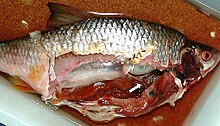Physostome
This article includes alist of references,related reading,orexternal links,but its sources remain unclear because it lacksinline citations.(March 2024) |

Physostomesare fishes that have a pneumatic duct connecting thegas bladderto thealimentary canal.This allows the gas bladder to be filled or emptied via the mouth. This not only allows the fish to fill their bladder bygulping air,but also to rapidly ascend in the water without the bladder expanding to bursting point. In contrast, fish without any connection to their gas bladder are calledphysoclisti.
The physostome fish encompass thebichirs,gars,a number ofcarps,trouts,herrings,catfish,eelsand thelungfish.While the gas bladder in fish mainly serves as abuoyancyorgan, some physostomes (though not all) can use their gas bladder as alung,allowing them to live from atmospheric oxygen in conditions where aquatic oxygen levels have dropped to a point which would kill other fish.
References
[edit]- Steen, Johan B. (1970)."The Swim Bladder as a Hydrostatic Organ".Fish Physiology.Vol. 4. San Diego, California: Academic Press, Inc. pp. 413–443.ISBN9780080585246.
External links
[edit]- Martin, W. (2000)."Swimbladder Physiology".Davidson College.Archived fromthe originalon 16 September 2012.

